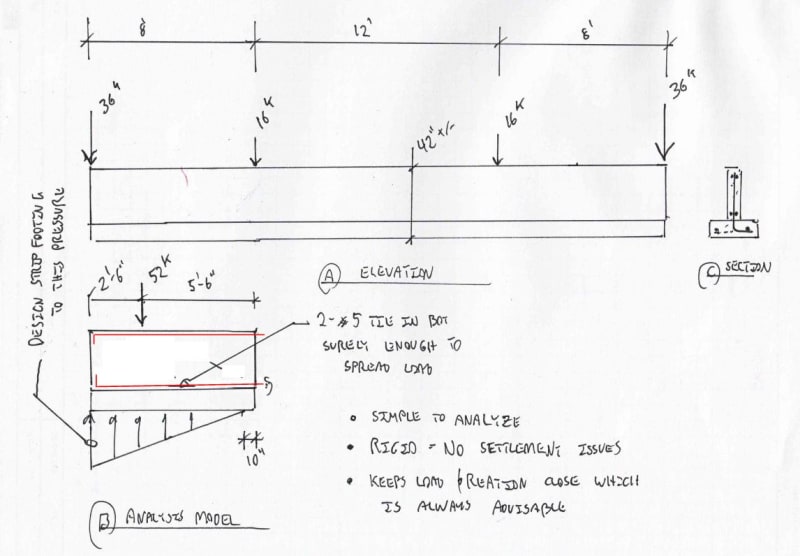DetroitJon
Structural
I'm working on a strip footing for a small commercial building. Soils are medium-dense sand with a bearing capacity of 2,500 psf for strip footings and a max strip footing width of 2'. The building footprint is 28' wide and while I can extend the footing on one side about two or three feet, the other side is constrained by a retaining wall that the footing will run into the heel of. The loading on the footing is two 36k column loads on each end and 16k in the two spots located 8' from each end.
I'm looking at this as a ~100k load on a footing with a 150k capacity (2'x30x'2.5ksf) so it's possible at least. The geotech eng. gave me a modulus of subgrade reaction of 150 pci for engineered fill on site, though he might bump that up since we're setting this on native soil. I know the footing is in negative bending and will need a bunch of steel at the top in addition to the steel at the bottom. I'm trying to figure out how to analyze this to get some efficiency with footing depth vs steel content. Especially with the sandy soils, are uncoupled springs a good (enough) way to model the soil? Do I need to go full FEA on this? I was thinking about setting the concrete depth to avoid needing stirrups for shear as this is in a smaller town (not Detroit) and competent labor is a little hard to come by.
I'm looking at this as a ~100k load on a footing with a 150k capacity (2'x30x'2.5ksf) so it's possible at least. The geotech eng. gave me a modulus of subgrade reaction of 150 pci for engineered fill on site, though he might bump that up since we're setting this on native soil. I know the footing is in negative bending and will need a bunch of steel at the top in addition to the steel at the bottom. I'm trying to figure out how to analyze this to get some efficiency with footing depth vs steel content. Especially with the sandy soils, are uncoupled springs a good (enough) way to model the soil? Do I need to go full FEA on this? I was thinking about setting the concrete depth to avoid needing stirrups for shear as this is in a smaller town (not Detroit) and competent labor is a little hard to come by.

